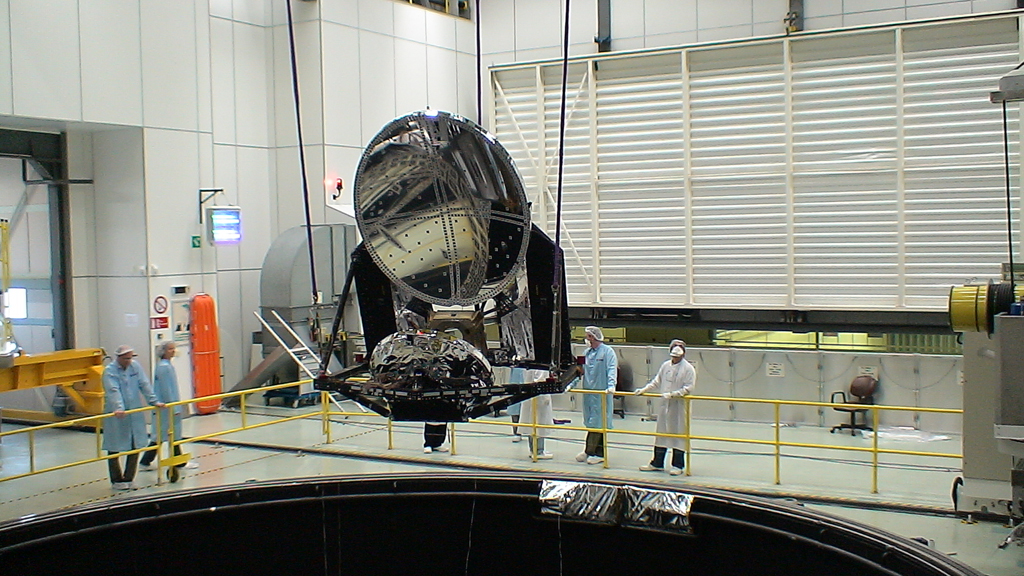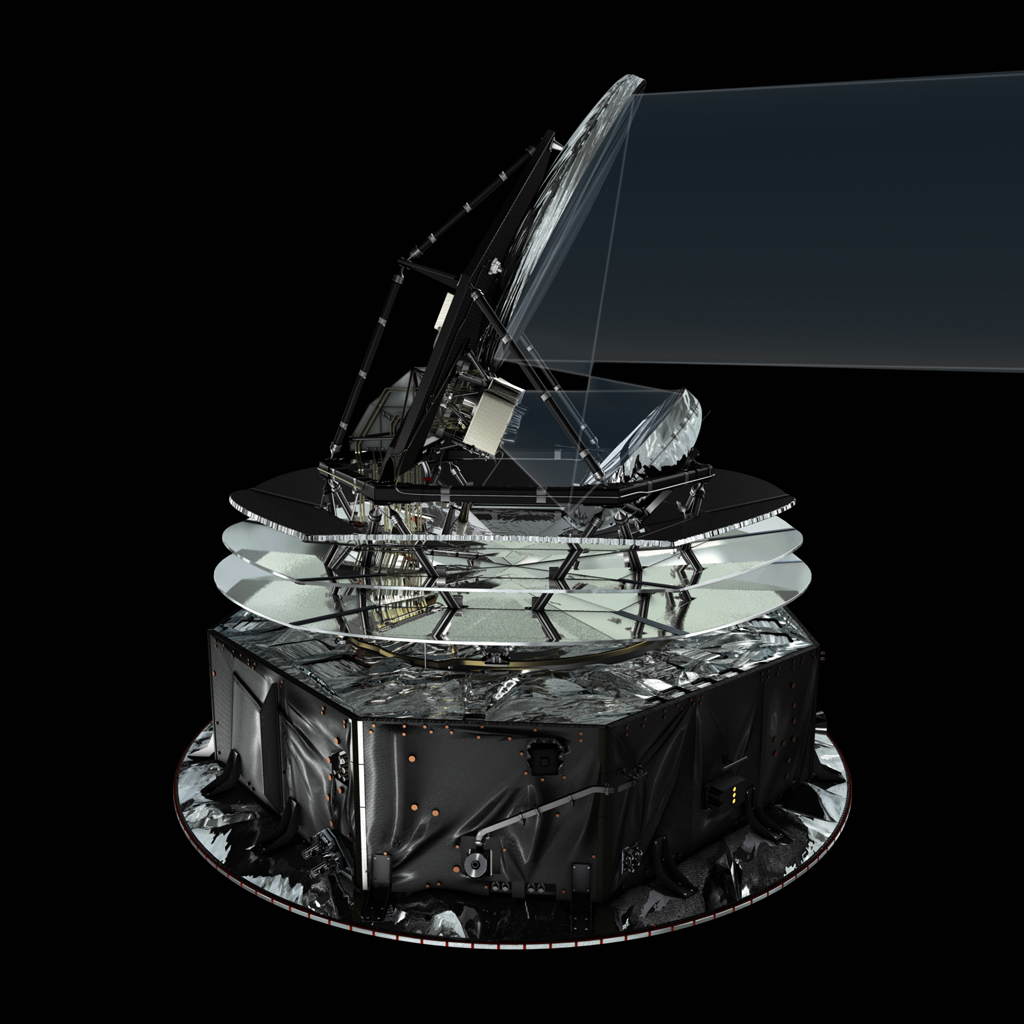The Planck Space Telescope: Surveying the sky
- Launch: May 14, 2009
- Status: Mission completed
Planck is Europe's first mission to study the birth of the Universe. Planck was launched jointly with the Herschel Space Observatory aboard an Ariane 5 rocket, on May 14, 2009. The satellite is the most sensitive telescope ever designed to study the cosmic microwave background--the remnants of radiation from the Big Bang 13.8 billion years ago. Planck's detectors measure the temperature of this light, searching for regions that are slightly warmer or colder than the average. These small fluctuations in temperature, called anisotropies, provided the seeds for the formation of galaxies that exist today.
The Planck satellite is giving astronomers a glimpse of conditions near the beginning of the Universe. The mission's objective is to help answer some fundamental questions of modern science: How was the Universe formed? How has it evolved to its present form? And what shape will it take in the future? Scientists thereby hope to establish which theory best explains the origin of all cosmic structures.
Drs J. Richard Bond of the University of Toronto and Douglas Scott of the University of British Columbia co-lead a Canadian science team that plays a key role in the Planck collaboration. Dr. Bond is on the faculty at the Canadian Institute for Theoretical Astrophysics (CITA) and directs the Cosmology and Gravity Program of the Canadian Institute for Advanced Research (CIFAR). The team includes astrophysicists at the University of Toronto, University of Alberta, Université Laval and McGill University.
Planck reveals hidden riches of the cosmos
Canadian astronomers help create unprecedented survey of the Universe
Less than two years on the job and the Planck space telescope has uncovered a treasure trove of strange and mysterious objects scattered across the Universe that will keep astronomers busy for years to come.
Canadians are part of an international scientific team that has been pouring over a new survey of the entire sky taken in microwave wavelengths by Planck, a mission launched in 2009 by the European Space Agency (ESA) and supported by the Canadian Space Agency. They have assembled a unique catalogue of thousands of new objects ranging from some of the largest structures in the Universe–clusters of galaxies–to the very smallest: cold dust, the actual building blocks that help form new generations of stars.
This animation illustrates the position on the sky of all foreground objects detected by Planck during its first all-sky survey and how they compare to the microwave view of the sky as seen by Planck. The size of the spots displayed in the series of images reflects the brightness of the sources.
Data from Planck has been used to compile a catalogue containing a wide variety astronomical objects, both galactic (features in the galactic interstellar medium, cold molecular cloud cores, stars with dust shells) and extragalactic (radio galaxies, blazars, infrared-luminous galaxies, and galaxy clusters). (Credit: ESA/ Planck Collaboration)
Planck's mission is to capture the heat left behind from the birth of our Universe, known as the Cosmic Background Radiation. This ancient light is considered the radiation echo of the Big Bang that has weakened and shifted toward the faint infrared and microwave parts of the spectrum.
Planck's supersenstivity to microwaves has allowed it to detect 189 gigantic clusters of galaxies, including 20 that have never been seen before. When this ancient shockwave of microwave background travels through a cluster of galaxies, it shifts the energy levels of the radiation, leaving behind a distinctive spectral signature that Planck can see. Hopes are now high that this new hunting technique will lead to the discovery of thousands of clusters, which could shed light on the overall structure and evolution of the Universe.
By mapping the sky in these longest of wavelengths (beyond what the human eye can see), Planck is also providing a detailed and first-of-its-kind inventory of a menagerie of foreground structures–cosmic stuff in the foreground of this relic radiation emitted some 13 billion years ago.
Among the most peculiar finds include the presence of extremely rapidly spinning dust grains scattered across the star-forming regions of the Milky Way and neighbouring satellite galaxies. They not only emit microwaves like most other dust encountered so far, but they also send out radiowaves as they spin. Astronomers are now grappling to understand how the smallest dust grains in the Universe, made up of only 10 to 50 atoms, can rotate 10 billion times a second!
Another Planck discovery puzzling astronomers is something called "dark gas," a new type of molecular gas found clinging to the edges of giant molecular clouds within the Milky Way. Dark gas may have an impact on galaxy formation and evolution.
In this most detailed survey of cold dust in and around the Milky Way ever conducted,. Planck has also catalogued nearly a thousand clumps of gas and dust, dubbed "cold cores," that are scattered across our local stellar neighbourhood. The coldest known objects in the Universe, cold cores are star factories in the making, and as such will play a key role in our understanding of the very earliest stages of star birth.
"We have never had an all-sky survey at these frequencies and resolutions before," said Douglas Scott, University of British Columbia professor and Canadian investigator for Planck mission. "So there are literally thousands of objects that we are beginning to see for the first time, many which we don't exactly yet know what they are."
The Planck Space Telescope mission is led by the ESA, and includes contributions from the CSA. The CSA funds two Canadian research teams that are part of the Planck science collaboration, and who participated in the development of both of Planck's science instruments, the Low Frequency Instrument (LFI) and the High Frequency Instrument (HFI). Professor Douglas Scott of the University of British Columbia is leading the Canadian LFI team. The HFI team is led by Professor J. Richard Bond of the University of Toronto.
Mapping the sky with Planck
Planck measures 4.2 metres high and has a primary mirror 1.5 metres in diameter. The satellite weighs 1900 kilograms. During the planned 15-month mission, the two instruments on Planck will receive and analyze the radiation captured by the mirror. The Low Frequency Instrument (LFI) and the High Frequency Instrument (HFI) will complement each other to analyze the light gathered during the two complete microwave surveys of the sky. These two cameras cover different areas of the light spectrum. The LFI will operate like a transistor radio and the HFI will convert the electromagnetic radiation into heat for subsequent analysis. The satellite is in orbit around the second Lagrange point (a stable point in space located 1.5 million kilometres from Earth) and is kept at a temperature approaching absolute zero.

Planck's 1.5-metre mirror during testing. (Credit: ESA)

Illustration of Planck (Credit: ESA)
Canada participated in the development of the LFI and HFI, the two instruments on Planck, mainly through development of the rapid interpretation software and the real-time analysis software that will make it possible to verify the data in the preliminary stages of the mission. The data analysis software for the LFI and HFI were developed in parallel by two teams, one at the University of British Columbia and one at the University of Toronto, both funded by the CSA.
Professor Douglas Scott of the University of British Columbia is leading the Canadian LFI team. The HFI team is led by Professor J. Richard Bond of the University of Toronto. The Canadian teams have spent more than a decade working with their international colleagues to plan for the Planck mission, and will be directly involved in using the data to answer some of the biggest questions in the Universe.
News
- - Astronomers glimpse clusters of galaxies forming
- February 5, 2015 - When were the first stars born?
- - Starry night: brushstrokes of dust in the Milky Way
- - The Planck Space Telescope receives its final commands
- - Planck Space Telescope spots hot gas bridging galaxy cluster pair
- - New Planck maps reveal unseen details throughout the Milky Way
- - Planck's HFI completes its survey of early Universe
